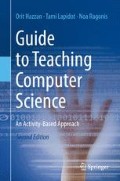Abstract
This chapter presents an optional organization theme for the Methods of Teaching Computer Science (MTCS) course around the concept of recursion. Based on the active learning-based teaching model, a series of themes is suggested, each one highlights a different pedagogical perspective. The themes are: classification of recursive phenomena (a nonprogramming task), the “leap of faith” approach, models of the recursive process, research on learning/teaching recursion, how does recursion sound? (the case of trees and fractals), evaluation (a nonprogramming project and a test construction), and a list of additional activities that illustrates that recursion can, indeed, be the focus of almost any topic discussed in the MTCS course. Each theme is accompanied with activities devoted to recursion to be facilitated in the MTCS course.
Access this chapter
Tax calculation will be finalised at checkout
Purchases are for personal use only
Notes
- 1.
Recursion is only one candidate for such course organization. Other central computer science themes, such as abstract data types or CSE research, may also be used for the same purpose.
- 2.
This activity relates also to Chap. 3 (what is CS and its relations to other fields, diversity of learners).
- 3.
This observation is not surprising since the phenomena were chosen very carefully so that they represent recursive structures and entities.
- 4.
This simplicity refers to the fact that a recursive algorithm is usually short with only few instructions.This fact stands in contrast to the complex process invoked by a recursive algorithm.
- 5.
Harvey calls these little people elfs or specialized doctors.
- 6.
The name tags are attached to the inner side of the pocket to emphasize the fact that the namesof an expert’s variables are not exposed to other little people (indeed, they should not know these names); they should know only the number of pockets and the kind of thing (types of variables) that can be put inside them.
- 7.
In the full implementation of the little people model there are experts also for the System.out.println command and the if statement; this assumption is not necessary for our discussion.
- 8.
The chalk holder represents the active actor at each stage of the role play.
References
Bruce KB, Danyluk A, Murtagh T (2005) Why structural recursion should be taught before arrays in CS 1. SIGCSE Bull 37(1):246–250
Eglash R, Krishnamoorthy M, Sanchez J, Woodbridge A (2011) Fractal simulations of African design in pre-college computing education. ACM Transac Comput Educ (TOCE) 11(3):1–14
George CE (2000) ERSOI—Visualising recursion and discovering new errors. Proceedings of the 31st SIGCSE technical symposium on computer science education, Austin, Texas pp 305–309
Gersting JL (1996) Mathematical structures for computer science (3rd edition). WH Freeman, New York
Götschi T, Sanders I, Galpin V (2003) Mental models of recursion. Proceedings of the 34th SIGCSE technical symposium on computer science education, Reno, Nevada
Harvey B (1997) Computer science logo style—volume 1: Symbolic computing 2/e. MIT Press, Cambridge
Harvey B, Wright M (1999) Simply scheme: introducing computer science 2/e. MIT Press, Cambridge
Hofstadter D (1979) Godel, Escher, Bach—an eternal golden braid. Vintage, New York
Lapidot T, Hazzan O (2005) Song debugging: merging content and pedagogy in computer science education. Inroads—SIGCSE Bull 37(4):79–83
Lapidot T, Levy D, Paz T (2000) Functional programming for high school students. (in Hebrew). Migvan—R & D in Computer Science Teaching, Technion, Haifa
Levy D (2001) Insights and conflicts in discussing recursion: a case study. Comp Sci Educ 11(4):305–322
Mirolo C (2011) Is iteration really easier to master than recursion: an investigation in a functional-first CS1 context. In Proceedings of the 16th annual joint conference on Innovation and technology in computer science education (ITiCSE ’11). ACM, New York, p 362
Pevac I (2012) First experiences with tutor for recursive algorithm time efficiency analysis. J Comput Sci Coll 28(1):56–65
Settle A (2014) What’s motivation got to do with it? A survey of recursion in the computing education literature. Technical Reports. Paper 23. http://via.library.depaul.edu/tr/23. Accessed 1 June 2014
Shulman LS (1986) Those who understand: knowledge growth in teaching. J Educ Teach 15(2):4–14
Vickers P (1999) CAITLIN: Implementation of a musical program auralization system to study the effects on debugging tasks as performed by novice Pascal programmers. Doctoral thesis, Loughborough University, UK. http://computing.unn.ac.uk/staff/cgpv1/caitlin/index.htm. Accessed 22 Sept 2010
Author information
Authors and Affiliations
Corresponding author
Rights and permissions
Copyright information
© 2014 Springer-Verlag London Limited
About this chapter
Cite this chapter
Hazzan, O., Lapidot, T., Ragonis, N. (2014). Integrated View at the MTCS Course Organization: The Case of Recursion. In: Guide to Teaching Computer Science. Springer, London. https://doi.org/10.1007/978-1-4471-6630-6_12
Download citation
DOI: https://doi.org/10.1007/978-1-4471-6630-6_12
Published:
Publisher Name: Springer, London
Print ISBN: 978-1-4471-6629-0
Online ISBN: 978-1-4471-6630-6
eBook Packages: Computer ScienceComputer Science (R0)

